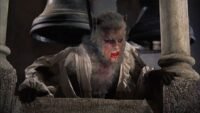By 1962, Hammer’s Gothic world had already been soaked in blood and revelation. Dracula and Frankenstein had rewritten the language of British horror; The Curse of the Werewolf had turned that language into lamentation.
And then came The Phantom of the Opera — not a storm of violence, but a sigh.
Terence Fisher’s Phantom is the quietest of Hammer’s major Gothic works, and because of this, perhaps the most misunderstood. It replaces the crimson rage of Dracula with melancholy, the hubris of Frankenstein with loss. Where those films roared with moral fire, Phantom murmurs through dust and memory.
It is less a tale of horror than a requiem for the artist — a film about creation devouring its creator, beauty born of suffering, and art as the last refuge of the damned.
The Last of the Romantics
From the opening overture, Fisher sets a different tone. Gone are the thunderclaps and catacombs; the film opens instead on a burst of music — the opera house alive, the chandeliers glinting, the crowd rapt. Beauty reigns.
But beauty, in Fisher’s world, is never innocent.
Beneath the stage, a shadow moves — not the creature of lust or vengeance, but of grief. Herbert Lom’s Phantom is no cackling villain or lovesick ghoul; he is a scholar, a composer, a man who once believed that creation could lift the soul.
What’s left of him now is the echo of that faith.
Lom plays him as a man hollowed out by betrayal. His music has been stolen by the venal Lord Ambrose D’Arcy (a superbly loathsome Michael Gough), his body destroyed by fire, his soul condemned to the catacombs.
He is the artist as martyr, Fisher’s most personal monster — not the damned seeking blood, but the believer seeking purpose.
Fisher’s Temple of Shadows
The opera house itself is the film’s cathedral — a structure built upon sin and devotion. Fisher directs it like a sacred space desecrated by commerce.
Above ground, it gleams with aristocratic decadence: chandeliers, velvet drapery, the illusion of grandeur. But below, in the tunnels, lies the truth — water dripping like tears, the walls lined with manuscripts and ghosts.
Cinematographer Arthur Grant paints the film in soft chiaroscuro — gold against black, silk against stone — creating a dual world of light and shadow that mirrors the Phantom’s divided existence.
The visual rhythm recalls The Brides of Dracula: sacred beauty haunted by decay. But where Brides pulsed with erotic delirium, Phantom aches with quiet sorrow.
This is Hammer’s most elegiac space — a world literally built upon music and death.
Herbert Lom’s Tragic Saint
Lom’s performance is the soul of the film. His Phantom is not a beast in need of pity; he is a moral being, trapped in contradiction.
When he speaks to Christine (Heather Sears), it’s not seduction — it’s benediction. He teaches her to sing as though instructing a soul in prayer. His voice trembles with awe, not lust.
Fisher frames these scenes with reverence. The camera never invades; it observes. Lom’s Phantom, masked and shrouded, becomes less a man than a spirit — an angel fallen not through sin, but through disappointment.
There is one moment that defines him: when Christine finally sees his face, and instead of rage, he bows his head in shame. Fisher holds the silence. The horror is not in the disfigurement, but in the humility of it.
For the first time in Hammer’s Gothic universe, the monster does not curse God. He apologizes to Him.
The Theatre of Cruelty
Michael Gough’s Lord D’Arcy stands as the film’s true villain — a predator in powdered wigs, embodying the corruption Fisher always saw in power. He is art without soul, intellect without empathy.
Every sneer, every casual cruelty drips with blasphemy. When he dismisses his musicians or humiliates his singers, it’s as if he’s spitting on the altar.
Fisher’s moral geometry is clear: art divorced from morality becomes desecration. D’Arcy profits from creation but never feels it. The Phantom, by contrast, feels everything — the pain, the beauty, the faith in art as salvation.
The contrast between them forms the film’s true conflict:
the soul of art versus the machinery of artifice.
D’Arcy represents the world’s indifference to beauty; the Phantom, its cost.
Christine: The Voice of Innocence
Christine Charles (Heather Sears) is one of Fisher’s most sympathetic heroines — not a damsel, but an unwitting priestess of the Phantom’s faith.
Where Fisher’s earlier women (like Marianne in The Brides of Dracula or Kitty in The Two Faces of Dr. Jekyll) are torn between repression and temptation, Christine is untouched by either. She exists as potential — a blank page waiting for music.
The Phantom sees in her not desire, but redemption. Her voice, pure and uncorrupted, becomes the vessel for his broken art.
There’s something hauntingly ritualistic about the way Fisher shoots their scenes together. Her singing echoes through the cavern like prayer. His listening becomes worship. In another director’s hands, this might have become romance. In Fisher’s, it becomes atonement.
The Music of the Damned
Music dominates The Phantom of the Opera more than any other Hammer film — not just as soundtrack, but as moral structure.
Don Banks’ score moves between romantic tenderness and Gothic grandeur, binding Fisher’s theology to melody. When Christine sings, the music feels divine. When the Phantom plays, it feels like confession.
The most powerful motif, however, is silence. Fisher uses it like a blade — cutting through the opera’s spectacle to reveal the emptiness beneath.
Silence is the Phantom’s true companion. It is his punishment, his prayer, and ultimately, his peace.
Fire and Redemption
When the film reaches its climax — the collapsing stage, the roaring fire — it feels less like an act of violence and more like ritual purification.
The Phantom saves Christine from the falling chandelier, carrying her to safety as flames consume his temple. Fisher’s camera lingers on his face as the firelight flickers across it — a man lit by the very beauty that destroyed him. There is no rage, no vengeance, no monstrous death cry. Only acceptance.
For Fisher, redemption is never triumphant. It comes through self-sacrifice, through the surrender of the self to the ideal. The Phantom dies not as a villain redeemed, but as an artist completing his final composition — a requiem in fire.
The music stops. The silence returns. And in that silence, Fisher finds grace.
The Fall of Hammer’s Romanticism
The Phantom of the Opera marked a quiet turning point. Its failure at the box office discouraged Hammer from such subdued, introspective storytelling going forward. Audiences wanted blood, not sorrow.
But in retrospect, Phantom feels like Fisher’s farewell to the romantic Gothic — his last plea for beauty before the descent into pure spectacle. Later films would embrace violence and sexuality with open arms, but here, everything still aches with yearning.
It’s the end of innocence for Hammer — and the beginning of self-awareness.
Final Thoughts
The Phantom of the Opera is not a horror film in the conventional sense. It is a liturgy for the wounded, a requiem for art itself.
It transforms the monster into a saint, the scream into a song, the horror of disfigurement into the sorrow of creation. Fisher turns the Gothic inward once again — from the graveyard to the heart, from blood to melody.
The Phantom’s mask is not meant to hide evil. It hides faith — faith in art, in beauty, in something pure enough to survive the fire.
When the curtain falls and the music fades, what lingers is not terror, but tenderness.
Because in Hammer’s Gothic world, the truest monsters were always the ones who dared to feel.



